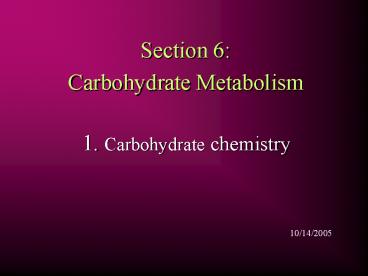Section 6: Carbohydrate Metabolism - PowerPoint PPT Presentation
1 / 14
Title:
Section 6: Carbohydrate Metabolism
Description:
Section 6: Carbohydrate Metabolism 1. Carbohydrate chemistry 10/14/2005 Overview of catabolism Carbohydrates aka saccharides (suffix: -ose) elements: C, H, O common ... – PowerPoint PPT presentation
Number of Views:346
Avg rating:3.0/5.0
Title: Section 6: Carbohydrate Metabolism
1
Section 6 Carbohydrate Metabolism
- 1. Carbohydrate chemistry
10/14/2005
2
Overview of catabolism
FATS
POLYSACCHARIDES
PROTEINS
Stage 1
amino acids
fatty acids,glycerol
glucose,other sugars
Stage 2
acetyl CoA
CoA
H2O O2
Stage 3
eCO2
Krebscycle
oxidativephosphorylation
v
v
ATP ADP Pi
1
adapted from Fig. 14.12
3
Carbohydrates
- aka saccharides (suffix -ose)
- elements C, H, O
- common empirical formula (CH2O)n n ???3
- monosaccharides
- aka simple sugars
- carbon chain unbranched
- 1 carbonyl (CO) group at end of chain
aldehyde not at end ketone - 2 or more OH groups
- OH groups n 1
- oligosaccharides/polysaccharides
- contain a few/many linked monosaccharides
2
4
Monosaccharides properties
- very polar (hydrophilic)
- functional groups
- OH H-bond donor acceptor
- O H-bond acceptor
- chemically reactive, especially the carbonyl
group, which reacts with - OH groups, forming rings oligosaccharides
polysaccharides - oxidants reductants
- amino groups on proteins (glycation)
3
5
Stereoisomerism (chirality)
- stereoisomers
- differ only in arrangement of atoms or groups
- any C with 4 different groups attached
(asymmetric or chiral C) - enantiomers a pair of molecules that are
nonsuperimposable mirror images of one another - example trioses
- simplest monosaccharides
- DHA achiral (no stereoisomerism)
- GA D L forms
- in general,
- possible stereoisomers 2n (n asymmetric
Cs) - D forms more common
rotating L D forms
4
6
Glucose
- most important monosaccharide
- the major monosaccharide in most organisms
- main form in which carbohydrate transported in
blood - main roles precursor of many biomolecules
energy source (fuel) - aka dextroseabbreviation glc
- 6 carbons a hexose
- carbon numbering starts atend nearest CO
- other hexosesfructose (frc)galactose
(gal)mannose
1 2 3 4 5 6
5
7
Glucose ring formation (cyclization)
- carbonyl C is subject to nucleophilic attack by
OH groups(arrow), forming a hemiacetal - 2 isomers form
- a OH projects on side of ring opposite from
C6 - (trans to C6)
- b OH projects on same side of ring as C6
- (cis to C6)
6
8
Glucose ring structure
- cyclic forms of monosaccharides are usually drawn
as Haworth projections, even though rings not
actually planar - tetrahedral geometry around each ring atom
causes 2 atoms to be out-of-planechair
conformation - 6-atom cyclic forms aretermed pyranoses
afterthe heterocycle pyran
7
9
Glucose isomers
- the a b isomers are called anomers the former
carbonyl C (C1 in this case) is called the
anomeric C - anomer formation aka anomerization
- anomeric C only one that has 2 of its bonds to
O - the reactions are rapid, reversible dont
need catalysts - forms in rapid-equilibrium with each other
- form at equil.
- open-chain lt 1 a 36 b 63
8
10
Glucosea b ring forms
- ball stick representations of
- the a b anomers
- galactose, an epimer of glc at C-4
1
a glc
4
4
1
b glc
b gal
9
11
Fructose isomers
- like glc, fructose forms pyranoses
- it also forms 5-atom rings called furanoses
- furanoses are major forms in frc derivatives
(e.g., sucrose) - C2 is the anomeric carbon
10
12
Oxidation
- carbohydrates with a free carbonyl group are
easily oxidized, i.e., they are good reducing
agents - termed reducing saccharides/sugars
- oxidation reaction is used to measure glc in
blood other fluids - glc oxidase more reliable than Cu2
- color developmentproportional toH2O2
11
13
Glycation of protein amino groups
- carbonyl groups react slowly reversibly with
amines, e.g., protein side chains
(abbreviation Pr-NH2) - the resulting aldimine rearranges very slowly
irreversibly to a ketimine - function of long-lived proteins can be impaired
- probable factorin long-termdamage causedby
high bloodglc in diabetesmellitus
12
14
Next2. Glycosides Polysaccharides































